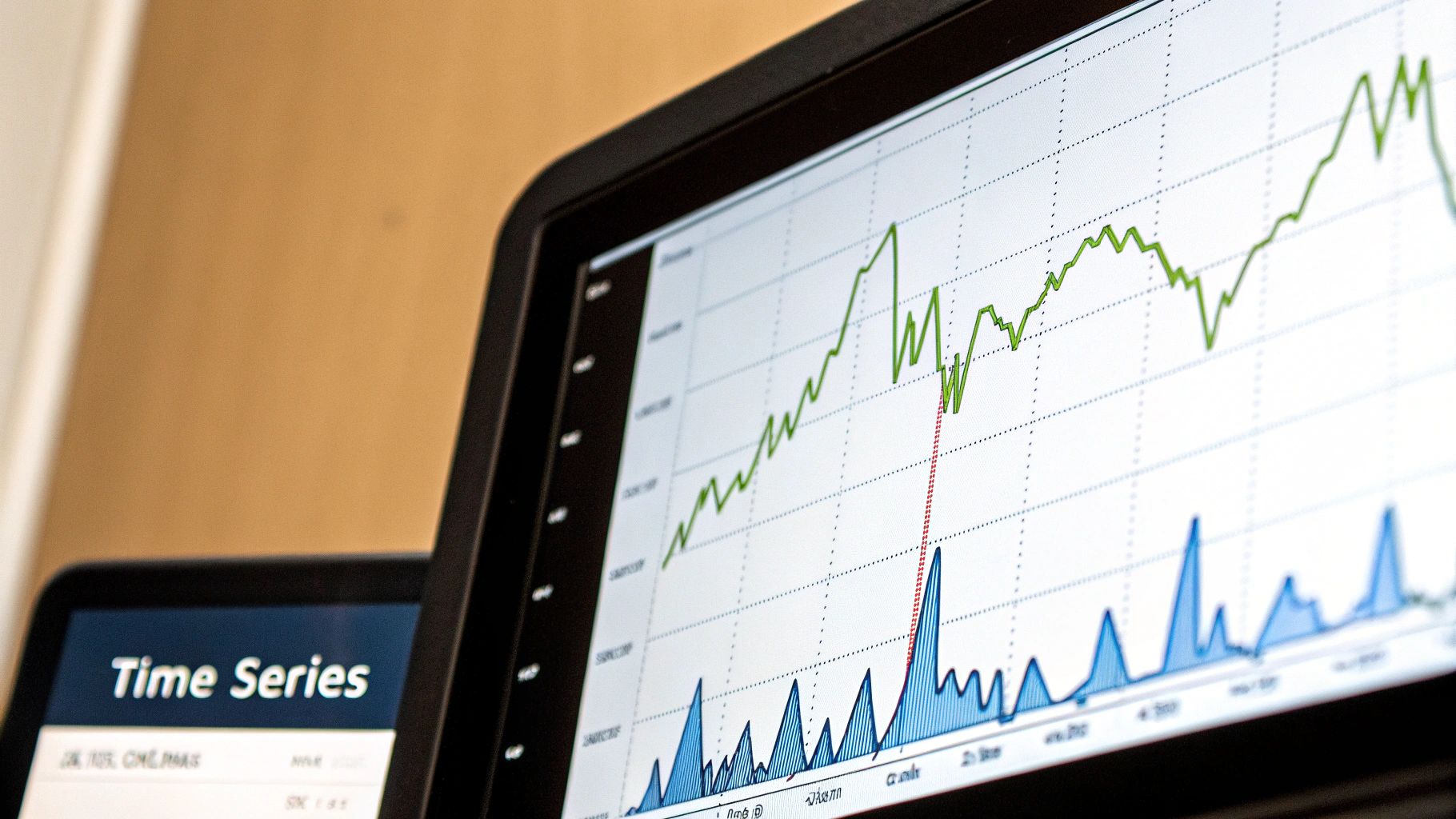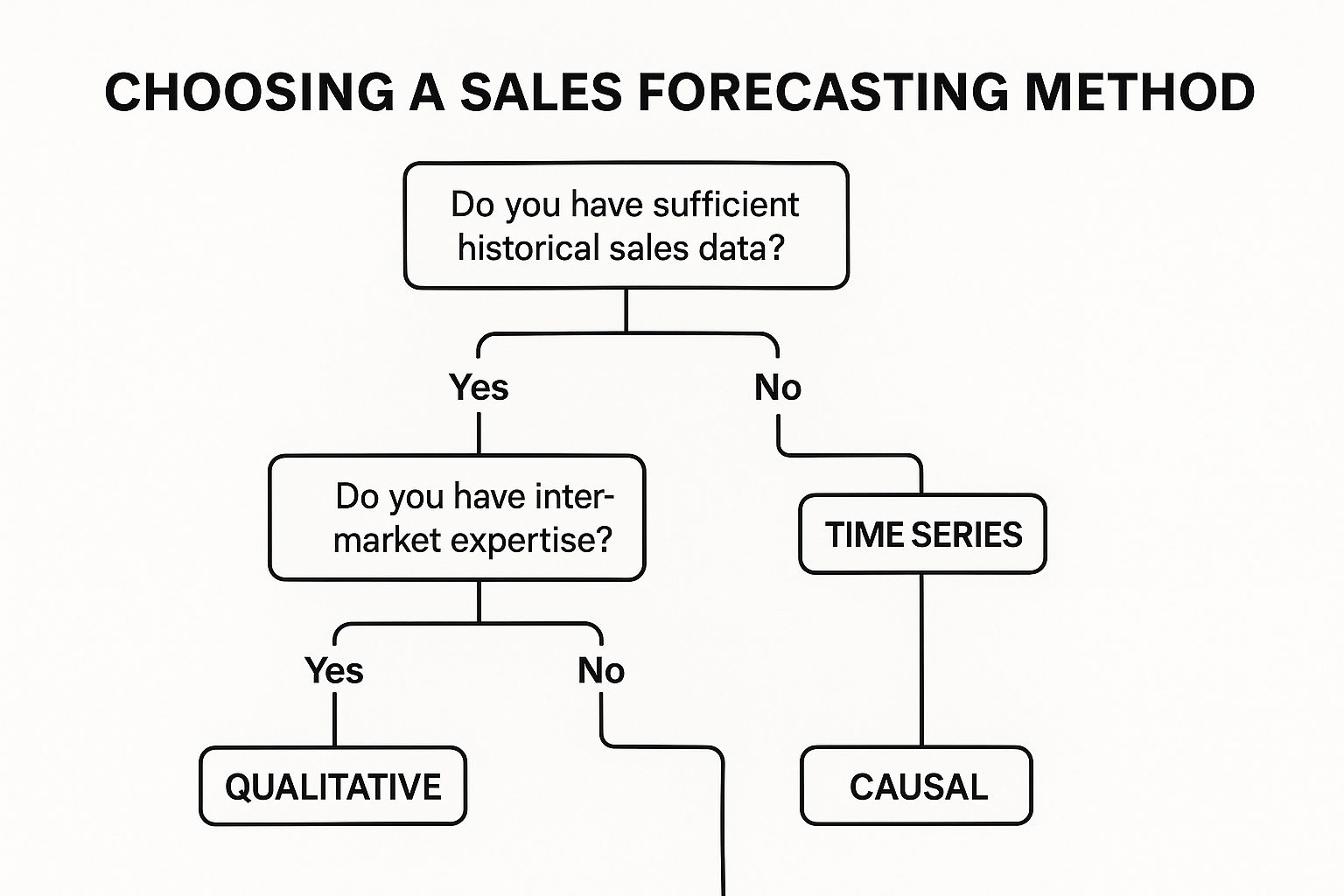Understanding The Sales Forecasting Methods Landscape
Navigating sales forecasting methods can feel overwhelming. Many businesses cycle through techniques without truly understanding their strengths. Successful companies, however, strategically choose methods based on their specific situations. I’ve spoken with many sales directors and finance executives, and I’ve noticed a significant shift from gut feelings to data-backed predictions that drive real business decisions. This shift is critical for realistic target-setting and informed resource allocation.
For instance, subscription businesses often flourish with recurring revenue models, enabling predictable forecasts based on churn and customer lifetime value. Project-based companies, however, with fluctuating contract values and timelines, often need a more adaptable method like pipeline forecasting. This highlights the need to align forecasting methods with your business model.
Market dynamics also matter. During economic downturns, scenario planning becomes essential to navigate potential market shifts.
Historical data analysis is another common method, using past sales data to predict future performance. This method assumes past trends will continue, making it simple to use with readily available data. Discover more insights on historical sales forecasting. However, depending solely on historical data during rapid market change or disruptive innovation can be misleading.
This underscores the need for a nuanced forecasting approach. The “best” method isn’t one-size-fits-all; it’s dependent on the context. The key to accurate predictions and informed decision-making is matching your forecasting method to your business model, team capabilities, and current market realities. Ignoring this often leads to choosing trendy methods over practical ones, leading to costly miscalculations. This understanding will allow you to choose forecasting methods that align with your specific needs, maximizing their effectiveness and avoiding expensive mistakes. Consider your available data, the predictability of your sales cycles, and the overall market conditions when making your decision.
Historical Data Analysis: Beyond Basic Number Crunching

Historical data analysis is a cornerstone of sales forecasting, but it’s often oversimplified. Many businesses fall into the trap of basic trend extrapolation, assuming past performance guarantees future results. Truly effective historical analysis demands a deeper dive – understanding the context behind the numbers.
For example, imagine a sudden sales spike. Was it driven by a successful, but temporary, marketing campaign? Or does it signal a genuine shift in demand? Distinguishing between these scenarios is crucial for accurate forecasting. This means asking critical questions about the factors that influenced past performance.
What market conditions contributed to previous successes or failures? Did external events, like a competitor’s exit or new regulations, skew the data? This granular analysis reveals the real drivers of performance, leading to more reliable projections. Simply projecting a consistent 5% annual growth rate, while convenient, overlooks the dynamic nature of markets.
Adjusting For Market Dynamics
Effective historical forecasting requires more than just looking at past numbers; it necessitates adjusting for the inevitable market shifts that shape future performance. Consider the impact of one-time events or seasonal variations. A competitor’s product launch last year, for instance, would inflate historical data, leading to an overly optimistic forecast for this year. Therefore, building frameworks that account for such market dynamics is essential.
This means incorporating market intelligence and competitive analysis into your historical data review. Learn more about winning tactics for historical sales forecasting.Inventory forecasting methods can also offer valuable insights into predicting future demand. For businesses in Ireland, understanding how to apply data-driven strategies within the local market is particularly important.
Recognizing Limitations
Finally, acknowledge the inherent limitations of historical forecasting. In times of market disruption or major product launches, relying solely on past data is risky. Introducing a new product category, for example, typically requires a different forecasting approach than predicting sales for established products.
Recognizing these limitations prevents over-reliance on historical data when its predictive power is weakest. In these situations, consider incorporating other forecasting methods, such as pipeline forecasting or market research. This nuanced approach keeps your sales projections grounded in reality, even during times of change.
Statistical Models: When Math Actually Beats Intuition

Statistical forecasting methods, like time series analysis and regression models, offer powerful tools for predicting sales with data-driven precision. But their effectiveness depends heavily on choosing the right model for your unique situation. Overcomplicating things can lead to wasted effort and inaccurate predictions.
Time Series Analysis: Decoding Predictable Patterns
Time series analysis shines at revealing patterns in historical data to project future trends. This sales forecasting method is especially helpful for businesses with predictable seasonality or consistent cyclical trends. Think of a retailer gearing up for the holiday season. Analyzing past sales data from similar periods allows time series models to anticipate demand fluctuations with impressive accuracy. This enables better inventory control, minimizing storage expenses while preventing stockouts.
However, these models operate under the assumption that historical patterns will persist. In times of market disruption or swift change, their predictive power weakens. A sudden economic downturn or a shift in consumer behavior could render past trends irrelevant.
Regression Models: Uncovering Causal Relationships
Regression models go deeper than simply projecting past trends. They seek to understand the core relationships between sales and various influencing factors. This lets businesses quantify the impact of specific variables on sales outcomes. A B2B software company, for example, might use regression analysis to pinpoint the optimal marketing spend for different customer segments. By modeling the relationship between marketing investment and sales conversions, they can confidently allocate resources to maximize ROI.
This deeper analysis provides a more nuanced understanding than simpler approaches. But regression models demand substantial, accurate data on all important variables. Incomplete or inaccurate data leads to unreliable predictions. Plus, pinpointing and measuring all relevant variables can be a complicated task.
To help illustrate the strengths and weaknesses of each approach, let’s examine a comparison table.
To help illustrate the strengths and weaknesses of each approach, let’s examine a comparison table.
Strategic Application: Matching Methods to Reality
The following table, “Statistical Forecasting Methods: Real-World Application Guide,” provides a strategic comparison of time series and regression models, illustrating when each approach provides superior results based on various business contexts and data characteristics.
| Method | Accuracy Potential | Data Requirements | Implementation Reality | Ideal Business Context | Warning Signs |
|---|---|---|---|---|---|
| Time Series Analysis | High for stable, predictable patterns | Historical sales data with clear seasonality or cyclical trends | Relatively straightforward; can be automated with tools like Forecast Pro | Businesses with established sales histories, predictable demand fluctuations (e.g., retail, CPG) | Market instability, significant external disruptions, new product launches |
| Regression Models | High when key variables are identified and accurately measured | Extensive data on sales and influencing factors; requires data cleaning and preparation | More complex; requires statistical expertise and specialized software like SPSS or R | Businesses seeking to understand drivers of sales, optimize marketing spend, analyze pricing strategies (e.g., B2B SaaS, manufacturing) | Incomplete data, difficulty in quantifying variables, complex sales cycles with numerous unknown influences |
This table emphasizes the importance of aligning the chosen forecasting method with both the available data and the specific business context.
The biggest takeaway? Statistical sales forecasting methods are powerful tools, not magic solutions. They require careful thought and application. With accurate historical data and well-defined variable relationships, these models can drastically improve forecast accuracy. But for businesses with simple sales cycles and limited data, simpler methods might be more suitable.
Choosing the right method is a strategic decision. It should be based on a realistic assessment of your business needs and available resources. Misapplying statistical models leads to wasted time, unnecessary complexity, and less accurate forecasts. Understanding the limits of each method is essential for effective forecasting.
Pipeline Forecasting: Where Human Insight Beats Algorithms

While statistical models play a valuable role in sales forecasting, sometimes the most accurate projections stem from a deep understanding of the subtleties within your sales pipeline. This isn’t about rejecting data; it’s about recognizing the strengths of human experience where algorithms may falter.
The Power of Contextual Information
Seasoned sales managers often possess an intrinsic grasp of their pipeline’s intricacies. They can discern between truly promising deals and those likely to stall, drawing on insights beyond simple data points. This contextual understanding, derived from discussions with prospects and sales representatives, is crucial. For instance, a sales leader might know that a deal labeled “highly probable” in the CRM is actually at risk due to an impending competitor bid.
This nuanced awareness is difficult to replicate in a statistical model. Algorithms excel at identifying trends in large datasets, but they often miss the subtle cues and specific circumstances that truly influence deal outcomes.
Avoiding Optimism Bias
A major hurdle in pipeline forecasting is optimism bias. Sales representatives, naturally driven to close deals, might overestimate their chances of success. This can inflate forecasts and skew revenue projections. To counter this, effective sales leaders use structured opportunity assessments. These assessments involve a methodical evaluation of each deal, considering factors such as the client’s need, the decision-making process, and the competitive landscape.
Identifying Key Pipeline Metrics
Not all pipeline metrics hold equal weight. Some, like the sheer number of open opportunities, can be misleading vanity metrics. Others, like average deal size and sales cycle length, provide more valuable insights into potential revenue. Experienced sales managers know which metrics genuinely correlate with closed deals. They use these key indicators to develop realistic forecasts and pinpoint areas for sales process improvement.
Building Practical Forecasting Processes
The best pipeline forecasting processes are those that sales representatives readily and consistently utilize. This involves building systems that are straightforward, intuitive, and integrated into their daily workflow. Successful teams often create practical methods for weighting deals based on realistic probability assessments. They also establish clear accountability for forecast accuracy, ensuring representatives are motivated to provide precise and timely data. This collaborative approach, blending data analysis with human judgment, results in more reliable sales forecasts.
Seasonal Patterns: Reading Business Rhythms That Matter
All businesses experience predictable fluctuations in activity. But the companies that truly thrive don’t just ride these waves; they anticipate them. These organizations know seasonal forecasting is about more than just tracking peaks and dips in sales. It’s about understanding the why behind the fluctuations.
Decoding the Drivers of Seasonality
Consider two retailers selling winter coats. One simply orders more inventory based on the previous year’s sales. The other digs deeper, analyzing weather patterns, economic outlooks, and emerging fashion trends. This in-depth analysis gives them a sharper edge in anticipating demand, avoiding excess inventory while meeting customer needs. B2B companies face similar seasonal dynamics. Quarterly budget cycles, industry events, and even vacation patterns can dramatically impact purchasing decisions.
For example, a software company serving educational institutions understands that their sales cycle mirrors the academic year. This knowledge lets them strategically time their marketing campaigns and sales outreach for maximum effectiveness. This strategic alignment sets them apart from competitors who take a more generalized approach throughout the year. Market trends and seasonal patterns are vital elements of sales forecasting, especially when analyzing historical data. Retail, for example, is known for its distinct seasonal shifts in sales. Learn more about retail forecasting and using historical data.
Separating Trends From Anomalies
One of the central challenges in seasonal forecasting is distinguishing actual trends from isolated occurrences. A summer heatwave may trigger a temporary surge in air conditioner sales, but this doesn’t necessarily signify lasting demand. Successful companies develop systems for separating these anomalies from true seasonal patterns. They examine historical data spanning several years, searching for consistent ebbs and flows that persist regardless of short-term market disruptions. This long-term view enables more informed decisions about inventory management, staffing, and marketing expenditures.
Integrating Seasonal Insights With Other Methods
Seasonal forecasting is not a stand-alone solution. It is most powerful when used in conjunction with other sales forecasting techniques. Consider a retailer gearing up for the holiday season. They might employ time series analysis to project overall sales growth based on past performance. They then incorporate seasonal insights to pinpoint specific peaks and valleys in holiday shopping activity. This blended approach creates a more robust and detailed forecast.
By grasping the underlying drivers of seasonality, differentiating true trends from isolated incidents, and integrating these insights with other forecasting methods, businesses gain the ability to anticipate their natural business rhythms. This proactive approach, combined with the flexibility to respond to unexpected market shifts, is what distinguishes those who react from those who anticipate and shape market trends.
Choosing Your Method: A Strategic Decision Framework
Choosing the right sales forecasting method is a crucial strategic decision. Many businesses, however, prioritize complexity over practicality. The best approach depends on realistically assessing your specific circumstances: data quality, business model complexity, market volatility, and team capabilities. Let’s explore a decision framework that aligns your forecasting method with your operational reality.

This infographic visualizes a decision tree for selecting the best sales forecasting method. The choice hinges on the availability of historical sales data and internal market expertise. Sufficient historical data often points towards Time Series forecasting. Strong internal expertise, even without robust historical data, can make Qualitative methods effective. When both data and expertise are present, Causal forecasting, incorporating various market factors, becomes viable. For a broader perspective on scaling sales, check out our guide on scaling B2B sales in Ireland.
Balancing Accuracy and Simplicity
Accuracy in forecasting shouldn’t sacrifice practicality. While complex statistical models can be powerful, they require clean data and clear variable relationships. For straightforward sales cycles, simpler methods like pipeline forecasting, focusing on opportunity assessments and probability weighting, might be sufficient. Choose a method your team can implement and maintain effectively. This means considering your team’s analytical skills and available resources. Overly complex methods can drain resources without proportionally improving accuracy.
Combining Methods: A Delicate Balance
Sometimes, combining multiple methods is the most effective approach. For example, a retailer might use time series analysis for overall projections but incorporate seasonal adjustments based on historical patterns and market research. This blended approach creates more robust forecasts, accounting for both predictable trends and market-specific nuances. However, combining methods can also add complexity. Ensure integration improves insights, not confusion.
To help you strategically select the best forecasting method, consider the following matrix:
Sales Forecasting Methods: Strategic Selection Matrix
Decision framework showing which forecasting approaches deliver optimal results for different business contexts and operational realities
| Business Context | Data Situation | Market Conditions | Optimal Method | Expected Outcomes | Implementation Reality |
|---|---|---|---|---|---|
| Established, predictable sales cycle | Abundant historical data | Stable | Time Series | Accurate baseline projections | Relatively easy with appropriate software (Tableau) |
| New product launch | Limited historical data | Volatile | Qualitative (Expert Opinion) | Directional insights, identify potential risks and opportunities | Relies on expert judgment, can be subjective |
| Complex sales cycle, multiple influencing factors | Moderate historical data, access to market data | Moderately volatile | Causal (Regression Analysis) | Understand key drivers, more nuanced projections | Requires statistical expertise, data preparation (Power BI) |
| Rapidly changing market | Limited historical data | Highly volatile | Pipeline Forecasting + Qualitative | Short-term accuracy, adaptable to change | Focus on current opportunities, requires regular updates |
This matrix provides a starting point for choosing the right method based on your unique situation. Remember, the best approach is often a blend of methods tailored to your specific needs.
Recognizing Warning Signs
The right method today might not be right tomorrow. Market disruptions, new product launches, or changes in your sales process can make your current approach ineffective. Regularly evaluate your forecasting method’s efficacy. Are your projections consistently accurate? Are they informing strategic decision-making? If not, reassess your approach. These warning signs indicate the need for a more adaptable and dynamic forecasting strategy. Decision-making frameworks can be valuable tools for this reassessment. Choosing your sales forecasting method isn’t a one-time event; it’s an ongoing process of evaluation and refinement. By honestly assessing your capabilities, understanding the trade-offs, and remaining adaptable, you’ll build a forecasting framework that truly drives strategic success.
Implementation That Actually Sticks
Implementing a new sales forecasting method isn’t about selecting the newest software or the most intricate algorithm. It’s about building a process your team will consistently use and that demonstrably improves results. This requires a strategic approach that considers your team’s current skills and realistic limitations.
Getting Buy-In From Your Sales Team
One of the biggest obstacles to implementing any new process is resistance from the people using it. Sales teams are often wary of new initiatives, especially if they appear to add administrative work without clear advantages. Successful implementation depends on getting their buy-in.
This means clearly communicating the reason for the change. Explain how better forecasts benefit not only the company, but the sales team itself. For example, accurate predictions can improve lead distribution, create more realistic quotas, and enable more effective sales strategies. Showing the value to individual team members is crucial for adoption.
Establishing Data Quality Standards
Accurate forecasts depend on reliable, consistent data. This means setting clear data quality standards and establishing procedures to maintain them. Collaborate with your sales team to define the essential data points needed for your forecasting method and develop practical guidelines for data entry. For instance, clearly define the criteria for categorizing opportunity stages and use a consistent naming convention for accounts. When selecting your sales forecasting method, consider established decision making frameworks.
Don’t strive for unrealistic perfection. Instead, focus on improving data quality gradually, beginning with the most important data points and expanding from there. Incremental, consistent improvements are more effective than attempting a complete overhaul immediately.
Creating Accountability Without Bureaucracy
Accountability is essential for accurate forecasting, but it shouldn’t create excessive busywork. Develop systems that monitor forecast accuracy and provide regular feedback to the sales team. This might include weekly or monthly reviews of individual forecasts, focusing on understanding the discrepancies.
Foster a culture of collaborative forecasting. Encourage open communication about deals, pipeline health, and market trends. This creates shared knowledge of factors influencing sales performance, leading to a more accurate overall forecast. For more insights, consider reading: what financial executives want from B2B vendors.
Piloting and Training For Long-Term Success
Before launching a new forecasting method company-wide, test it with a small group. This allows you to evaluate the process, find any problems, and collect feedback from the sales team in a controlled setting. After a successful pilot, develop a comprehensive training program to ensure the entire sales team understands the new method and its effective use. Continued coaching and support after the initial launch are crucial for long-term adoption.
The key to implementation is progress, not perfection. Focus on building sustainable improvements within your team’s capabilities and practical limitations. Prioritize buy-in, data quality, accountability, and training to create a forecasting process that delivers results and helps your team succeed.
Ready to improve your sales performance in Ireland? Visit DublinRush to learn how our data-driven platform can optimize your sales forecasting and help you achieve steady growth.
